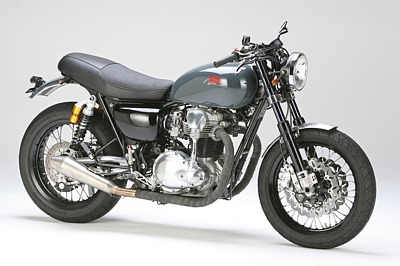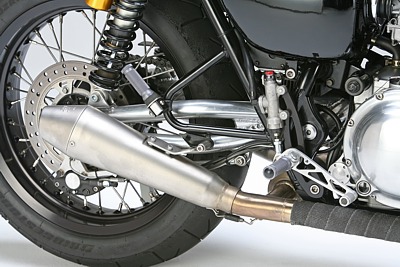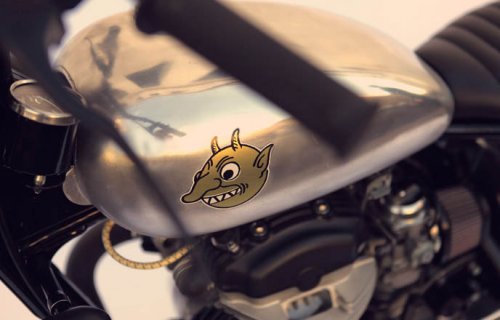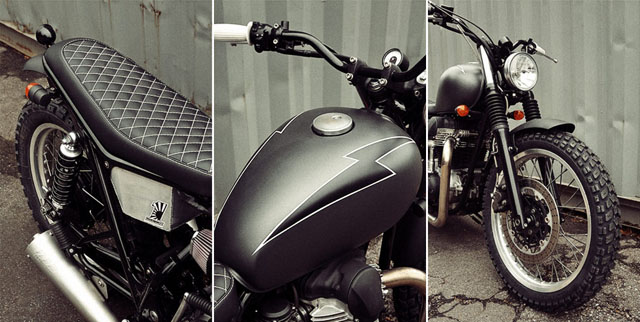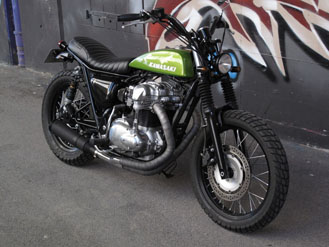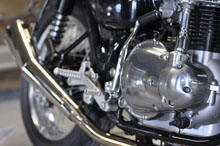|
|
||||||||||||||||||||||||||||||||||||||||||||||||||||||||
| главная ликбез новости мотокаталог форум мототюнинг кастом чоппер статьи карта сайта закажи мотоцикл | ||||||||||||||||||||||||||||||||||||||||||||||||||||||||
|
|
||||||||||||||||||||||||||||||||||||||||||||||||||||||||
 |
 |
 |
||||||||||||||||||||||||||||||||||||||||||||||||||||||
 |
|
 |
||||||||||||||||||||||||||||||||||||||||||||||||||||||
| Kawasaki W650 | ||||||||||||||||||||||||||||||||||||||||||||||||||||||||
|
||||||||||||||||||||||||||||||||||||||||||||||||||||||||
|
||||||||||||||||||||||||||||||||||||||||||||||||||||||||
| Технические характеристики Kawasaki W650 | ||||||||||||||||||||||||||||||||||||||||||||||||||||||||
|
||||||||||||||||||||||||||||||||||||||||||||||||||||||||
|
||||||||||||||||||||||||||||||||||||||||||||||||||||||||
|
||||||||||||||||||||||||||||||||||||||||||||||||||||||||
|
||||||||||||||||||||||||||||||||||||||||||||||||||||||||
|
||||||||||||||||||||||||||||||||||||||||||||||||||||||||
|
||||||||||||||||||||||||||||||||||||||||||||||||||||||||
|
||||||||||||||||||||||||||||||||||||||||||||||||||||||||
|
||||||||||||||||||||||||||||||||||||||||||||||||||||||||
|
||||||||||||||||||||||||||||||||||||||||||||||||||||||||
| Motorcycle Comparison: Kawasaki W650 Meets Triumph Bonneville | ||||||||||||||||||||||||||||||||||||||||||||||||||||||||
|
Kawasaki's W650 and Triumph's 2001 Bonneville rewrite history. From the June
2001 issuwe of Motorcycle Cruiser magazine.
Mining the past is big money these days, and products from Chrysler's PT Cruiser to Levi's bell-bottom jeans are geared toward serving Baby Boomers an updated slice of their fondest memories. Motorcycle manufacturers are no exception. Triumph Motorcycles, Ltd. and Kawasaki Motors Corp. are the latest concerns to join the fray with bespoked updates of their not-so-distant pasts. Both manufacturers have churned out new bikes based on the retro-style of the same era -- the late 1960s, specifically the British vertical twins that dominated the streets in those days. That both motorcycles hew so closely to the forms of their predecessors is a testament to the R&D teams of each manufacturer. But these twin-cylindere motorbikes, parallel though they may be, weren't exactly separated at birth -- each has a personality all its own. The W650: Closer to Fine We were idling the Kawasaki at a stoplight when a hirsute gent of suspicious means approached us, grunting, "I'll be a sumbitch...that's a Kawi?! That mother looks just like my old 650 Triumph...down to the tank!" He shuffled by with a wobbly thumbs up. That kind of reaction followed us everywhere we went whilst astride the W650, even in the seen-it-all attitude of the Los Angeles basin. And while Kawasaki's market studies for the 650 probably didn't include our hairy alcoholic pal, they surely determined that boomers who had seen it all were primed for remembrances. Kawasaki beat Triumph at its own game when it released the W650 last year, prior to the 2001 launch of the new Bonneville. But Kawasaki is no stranger to the retro game, as witnessed by its release of the pre-war styled Drifter a couple of years back. Kawasaki is also no stranger to the British-style vertical twin. The design of the W650 faintly recalls the lines of Kawasaki's W1 and W2 parallel twins from the late '60s, but that's really nothing to crow about; those models were never considered belles of the ball. The W designation and its 40-something horsepower is one of the few aspects this 650 carries over from its forebears -- it's really a recreation of the Triumph T120 idiom, even more than the current Triumph is. The W650 is pleasant enough around town and its twin cylinder air-cooled 676cc powerplant churns out a fair amount of midrange power, due partly to a long-stroke 360-degree crank that has both pistons rising and falling together. The modern four-valve cylinder heads offer better breathing for admirable torque, and the single overhead cam layout is simple and lightweight. Don't look for a pushrod though -- a neat design twist locates a vertical tube containing the cam drive outside the right cylinder for an exotic look. A pair of 34mm CV carbs deliver the goods efficiently, and the engine's broad powerband pulls from 1500 rpm on up, with a party-pooping flat spot just off idle to spoil your grins. You'll have to venture into higher revs for real motivation, and there'll be plenty wringing of hands and throttles on the W650 to squeeze out a response. This means plenty of trips to the gearbox, but that's no worry for the smooth-shifting five-speed tranny. Kawasaki's Positive Neutral Finder feature usually scores big points, but we found it getting in the way of rhythmic upshifts this time. Four gallons of regular unleaded gets us 140 miles away from the editorial ivory tower, and the rubber-mounted engine keeps obtrusive shaking under control, although we felt an annoying buzz past 6000 rpm -- right where the Kawasaki starts making good power. Never mind -- the eagerness of the W650 to eat up corners in any gear makes engaging in lower revs enjoyable. The front end steers so lightly you feel almost like you're on a bicycle, and the W650's traditional double cradle frame will keep you rigid throughout. The agility of the W650 compelled us to pitch it into corners with a vengeance, but the 39mm telescopic front fork gets a touch too flexy and the rear shocks a touch too soft at speed, even with new rebound and compression damping rates for 2001. Still, we'd call the W650 almost flickable if our sport riding brethren were out of earshot. Even with balancers and rubber mounts, the W650 makes no bones about its buzziness -- this is an elemental motorcycle through and through. And the brake backs up that confession. Squeeze the dual piston 300mm front disc, and it'll fade quickly under intense duress. When you venture out on a highway, things can get tremulous in a hurry. Passing maneuvers or uphill lunges have you twisting the throttle fiercely, but then, high speed blasting is not what the W650's about.  The W650 gets a wider bar than the Bonneville and a most welcome and aesthetically appropriate tachometer. The Kawasaki actually emits a meaty exhaust cadence from the pipes, whereas you'll be holding a paper cup to the Trumpet's faithfully recast peashooters to hear any discernible warble. Although the W650's seat is only one inch higher than the Triumph's, the difference feels like a foot. That's OK, because the Kawasaki's wide bar rises up to locate your arms at a comfy angle. With the footpegs straight under your feet, it all adds up to the ergonomic style of Bolt and Upright. This is great for street riding, but out on the highway, you'll find yourself surfing wind currents -- the same wide bar has you hung out in the drafts like yesterday's laundry. Nostalgia's flame burns brightest, and the rubber-gaitered fork stanchions of the W650 carry that torch forward without the oil pools of the past. Were it not for the Kawasaki badge on the W650 tank, you'd think this twin was of British descent. Insiders at Kawasaki even confided that seat logo lettering is easily dissolved with a swipe of solvent. And the tank badges pry off! It's almost as if the maker wants to encourage the creation of nameless retro twins just to confound drunks at stoplights...and the rest of us, too. New for 2001 is a half-degree increase in the steering angle, plus a larger axle and new front hub, intended to improve handling. Another welcome upgrade is a redesigned seat with more comfortable padding and retro white piping around the edges. The paint job is two-tone and top-notch, with the only choice being proper dark green and tan. We do wish the W650 wasn't so cold-blooded, as early morning starts usually required an intimate relationship with the choke lever. But look, Ma -- there's a real-live kickstarter. While you might shrug this bit off as gimmicky, you can't deny the rush of swinging down on the metal arm and hearing the engine crackle to life. The dual analog instrument faces recall gauges of the '60s, but the W650 sneaks in some modern amenities -- the tripmeter, odometer and clock are tucked into the speedo as a handy LCD display. Throw in a tach and groovy centerstand and you really start to appreciate the little things that $6499 will net you. There's even an integrated ignition/fork lock. And yes, an electric start, too. Building the Better Bonnie How do you recreate the archetypal sporting road bike, one that eventually became a cultural icon? (A vibrating, leaking cultural icon, but still...) Triumph had to tread carefully when redesigning the Bonneville legend, to not sully the memory of glorious British twins with a clumsy modern showboat. It was a tall order to recapture the sheer rush of the T120's quickness and agility, with none of the mechanical hiccups (or belches) that plagued the early models. Triumph's intent to produce a machine combining timeless appeal with modern function explains the new Bonnie's old-school 360-degree vertical twin layout and updated, four-valve heads. Rose-colored memories of the past don't always keep step with the latest technology, so Triumph decided to forego rigid historical accuracy and focused on making the 2001 reissue a solid, all-around motorcycle that pushed at least some of the warm and fuzzy buttons. Nevertheless, the designers were resolute in casting the bike closely to its forebear in look, geometry and size. The Bonnie's 790cc makes noticeably more power than the W650's 676cc, and in a smoother fashion. Two balancers in the upper half of the horizontally split cases arrest most of the intolerable vibration of your father's Triumph. But one ride on the brand-new Bonnie illustrates the main difference between it and the W650; where the Kwak comes up with a flaccid 41 bhp, the Triumph's twin jugs make a respectable 61 bhp. And the bike offers you gobs of torque and a powerband that lets you barrel down the road with nary a snick at the shifter. This Bonnie is beefier than the Kawasaki in every respect. What's even more respectable is the fact that most of the power is usable from 2700 rpm all the way to the rev limit. The Triumph's broad spread of grunt yields linear, easy acceleration too, except for a flat spot off idle. The Triumph's parallel twin cylinders are air-cooled, but they have two overhead cams instead of the pushrod valves of your dusty T120 model. A discreet oil cooler tucked behind the frame downtubes ensures consistent running temps. The powerplant looks chronologically correct, and the oil drain tube at the front of the engine is made to resemble a pushrod tube from the old unit. With the five-speed gearbox reversed, a final drive chain ends up on the right instead of the left, allowing room for the traditional Triumph engine case on the right. The twin balancer shafts reduce high-speed vibrations, but these are tuned to ensure the new iteration isn't overly smooth -- which we think it still is. A 4.3-gallon gas tank will spirit you out of city environs with room to spare, delivering range in the area of 150 miles. The Triumph's 29 degree rake makes for a more comfy commute at highway speeds. There's better feedback from the Bonnie's front end than the spindlier W650, probably due to the Triumph's stouter 41mm stanchions, which track a longer 58.8-inch wheelbase and 88.6-inch overall length. This bike is longer, lower and heavier than the Kawasaki, and the weight difference is noticeable. The Bonneville tips the scales at 499 pounds wet to the W650's 472 pounds. All those characteristics make this Triumph a stable ride -- we're talking cruiser vernacular here. But even though the Bonneville steers more heavily than the Kawasaki (keep in mind both bikes are more nimble than common cruisers), it's still eager to participate in twisty road euphoria. Naturally, the suspension on the Bonneville feels sporty, with chassis geometry similar to the '60s model. But there's also the comfort a semi-standard riding position brings. With a low 30.5-inch seat height and flat, wide bench saddle, the Triumph locates your feet just a hair to the rear of 90 degrees. The Brit bike's low bar has you hunched forward at a more aggressive angle than the W650 -- which we preferred over the long haul. The Triumph's five-speed transmission shifts efficiently and without fuss, albeit a bit loudly.  The Bonnie's speedo sits forlornly by the narrower handlebar, lacking the traditional Britbike tach to keep it company. The brakes are marginally better than the W650's, and we experienced a bit of fade with the front after intense use. The rear brake held up admirably though, and the Bonnie wins this round with its discs front and rear. We found the Bonneville's clutch to be so light and cornering clearance so reasonable, it fortified us with the glow of Anglophilia. So we dragged the limey lunk around a sanctioned track school for a couple of laps. It performed exceptionally well, given that it was surrounded by sportbikes the entire time. The Bonnie's exhaust system should look familiar to Triumph owners of the '60s -- the peashooter silencers follow the look of the original. There's a catalytic converter in some models and all incorporate an air-injection system to reduce emissions, but crack the 2001 throttle and all you'll hear is a stuttered whine from the pipe, and a sigh of disappointment from your lips. No worries, mate -- the classic tank badge on the side of the flowing, authentically scalloped gas tank still remains, complete with indents for optional knee pucks. Two-tone paint comes in red and silver and green and silver. And while we found the analog speedo to be serviceable, we couldn't understand why there wasn't a flippin' tach. We didn't find a tool kit either; and did we mention the ignition switch was buried somewhere to the side of the headlight? If looking for a place to hang your lid whilst parked at the local java hut, you're out of luck on the Bonnie. Unlike the Kawasaki, no thoughtful helmet lock is provided. Likewise, there isn't a centerstand, but you'll find it in Triumph's accessory catalog, along with a variety of other items to clamp onto the Bonnie. We understand beefier aftermarket exhausts are on the way, too. Triumph knew it had to take liberties with its new machine while emphasizing style, but knew the Bonneville also had to be a motorcycle that wasn't just a museum piece; it had to hold its own against the legend. With its torquey twin-cylinder engine, easy handling chassis, lean classical styling and popular $6999 price tag, the 2001 model captures the spirit of the old Bonnie well enough without relinquishing its raison d'etre to the whimsy of fashion. SPECIFICATIONS Suggested base price: $6599 SPECIFICATIONS Suggested base price: $6999 RIDING POSITIONS Jim O'Connor: Rationally, the Triumph is a better performer than the Kawasaki. No good ol' English charm here, just decent performance with no soul. I wanted to like the Bonnie because of its heritage, I just couldn't. And where's the tach? But look at the W650. What do I spy with my goggled eye? A kick-starter! One kick and it comes to life with the rumble sadly absent from the Triumph. The power is down, but I didn't miss it. I liked the Kawasaki's looks, and a nice cruise through sweepers convinced me the W650 is the "retro" to own. Cruising is what these bikes were made for and the Kawasaki does it better. If you want more performance, get the Triumph. For me? The Kawasaki gave me an impression of all the things that were great about the motorcycles of yore, without the hassles. Jim O'Connor Cherney: I didn't quite know what to make of the W650 at first. Was it a Japanese copy of an old Brit bike or just a bare-bones standard with a few nostalgic quirks? The bottom line is it's a hoot to ride -- mushy brakes, kickstarter and all. It simply looks groovy and works pretty darn good. And while the Bonneville had the reputation and benefit of years of admiration, it couldn't possibly live up to all that in its new incarnation...could it? I like the engine on the Bonnie way better than the W650, and the riding position and the suspension were superior, but the total package left me a bit cold. If the Bonnie is a fast and fun ride, the W650 is my pick for clown prince of the road, generating a few more smiles for my miles. Andrew Cherney Friedman: Face it. If there were lots of people who wanted classic British or Japanese middleweight vertical twins, they never would have stopped making them. Besides the legion of Brit bikes that have done the hippy-hippy shake off into oblivion and the original Kawasaki W1 and W2 series, we have bid farewell to the Yamaha 650 twin (which is still paid homage by a healthy owner's club), Honda's CB500 twin (and more recently a British style 500 single that barely arrived before it was gone). If you want one, I'd grab it fast, because they aren't likely to catch fire this time around either. Which one? Well, the Bonneville is functionally the better bike, more powerful and comfortable, but the W650 is a much more faithful recreation of those old Brit bikes and what it was like to ride them -- right down to the uncomfortable seat. It has the "character" that lovers of old crocks wax nostalgic about. Now as then, the character is better remembered than relived. Query Friedman about his character at Art.Friedman@primedia.com or at ArtoftheMotorcycle@hotmail.com. Related Articles Additional motorcycle road tests and comparison tests are available at the Road Tests section of MotorcycleCruiser.com.
|
||||||||||||||||||||||||||||||||||||||||||||||||||||||||


1999m.jpg)

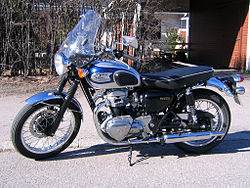


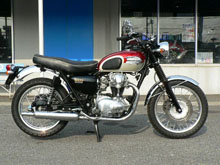

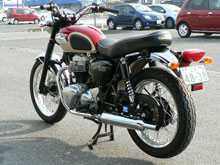











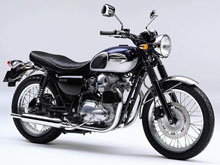



 Looks
are not everything, but they go a long way, and the W650 certainly has good
looks. In an age when smoothly faired super-bikes rule the roads, the W650
turns the heads of the onlookers as it passes by. Turner and Triumph got it
right, the looks, the technology and the performance. Add the
counter-balance shaft to reduce vibration to an aberration, front disc
brake to make stopping a reality, electronic ignition for reliability and
performance, a five speed gearbox with positive selection, electronic
speedo & tacho for smooth feedback to the eye, oil-tight seams on the
engine unit with and oil filter, shaft driven single overhead camshaft with
four valves per cylinder to give better breathing, a well tuned chassis
with alloy rims and modern tyres and an electric starter for the modern
generation and you have for some the perfect bike.
Looks
are not everything, but they go a long way, and the W650 certainly has good
looks. In an age when smoothly faired super-bikes rule the roads, the W650
turns the heads of the onlookers as it passes by. Turner and Triumph got it
right, the looks, the technology and the performance. Add the
counter-balance shaft to reduce vibration to an aberration, front disc
brake to make stopping a reality, electronic ignition for reliability and
performance, a five speed gearbox with positive selection, electronic
speedo & tacho for smooth feedback to the eye, oil-tight seams on the
engine unit with and oil filter, shaft driven single overhead camshaft with
four valves per cylinder to give better breathing, a well tuned chassis
with alloy rims and modern tyres and an electric starter for the modern
generation and you have for some the perfect bike. 
 Жизнь
порой преподносит такие невероятные сценарии, что даже самый неправдоподобный
писатель-фантаст будет жалобно покуривать в сторонке, удивляясь, как не смог
додуматься до такого поворота событий.
Жизнь
порой преподносит такие невероятные сценарии, что даже самый неправдоподобный
писатель-фантаст будет жалобно покуривать в сторонке, удивляясь, как не смог
додуматься до такого поворота событий.


